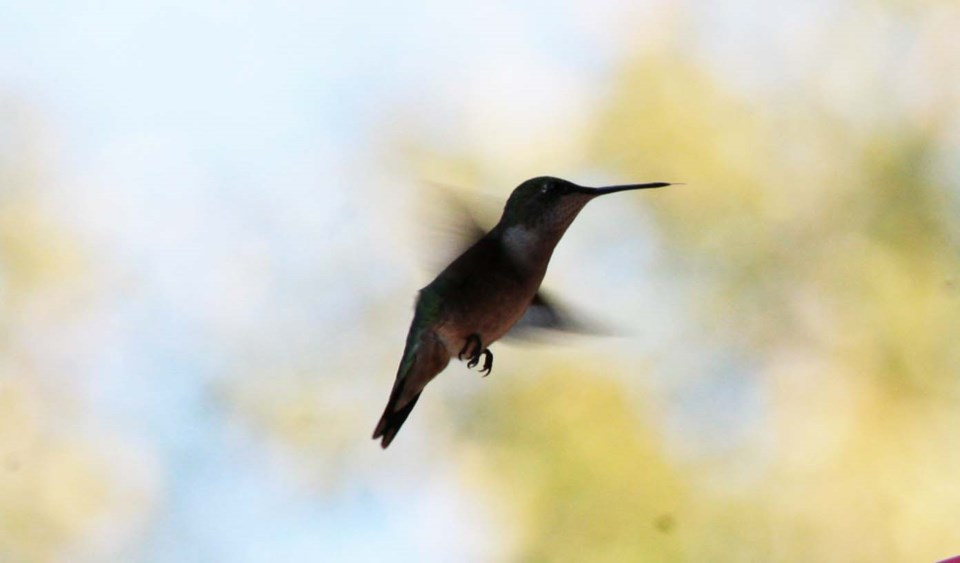Legends say that hummingbirds float free of time, carrying our hopes for love, joy and celebration. The hummingbird’s delicate grace reminds us that life is rich, beauty is everywhere, every personal connection has meaning and that laughter is life’s sweetest creation.
On the prairies, there are two species of hummingbirds – the Ruby-throated and the Rufous. The male Ruby-throated hummingbirds have green backs and heads, grey-white bellies and throats and green and black rounded tails with white tips. The Rufous hummingbirds are similar in size with males having reddish-brown backs and bellies, white chests, brown and black rounded tails with orange-red throats and a shiny green patch on their head. The females of both species are slightly larger and less showy. Amazingly enough, both of these tiny birds migrate on an annual basis to Mexico and Central America. Sometimes before you can see these little beauties you can hear the beat of their wings which “buzz” as they are beating 12 to 80 times each second. Due to this rapid wing pattern, they can hover and manoeuvre quickly.
These tiny little birds need to consume 1.5 to 3 times their body weight daily and feed on small insects, flower nectar and tree sap. Anyone who hangs up a hummingbird feeder can appreciate how wonderful this food source is to these birds. If you sit quietly and watch the birds feeding you can also notice that they will aggressively defend their food supply.
Male hummingbirds do not help to raise the young. The females build tiny cup-like nests that are difficult to see as they are concealed among branches. These nests out of necessity are often close to a food source. The females will lay two or three pea-sized eggs and within a couple of weeks, the young will hatch. The young birds are fed by the females and will fledge within the next 2 to 4 weeks. Nesting pairs and their young will often return to the same site each year after migration so once you have these birds used to your feeding stations, it is a good idea to continue to offer this food source.
Our boreal forest is a supreme natural habitat for these little lovelies. Some essential food sources for them in addition to nectar include small insets, larvae, insect eggs and spiders. These nutritional components are necessary for a balanced diet – especially for the rapidly growing hatchlings. Adult hummingbirds need to eat several dozen insects daily.
Sap is another food source when food is scarce. You can often see them sipping sap from wells drilled by woodpeckers. Some hummers have been observed eating ashes and sand in small quantities as well. However, it may be that instead of the ash or sand itself, the birds were consuming small insects that were present.
In general, hummingbirds are attracted to brightly coloured blooms that are in tubular shapes as these flowers typically produce lots of nectar. They will frequent areas with consistent blooms throughout the growing season so they are ensured of a constant food source. Another added benefit is while these birds move among plants sipping their nectar, they also spread pollen. Hummingbirds do not directly consume pollen but much pollen can be stuck on their bodies while sipping nectar. There are over a hundred native plant species which rely on hummingbirds to be their chosen source of cross-pollination.
— Hanbidge is the Lead Horticulturist with Orchid Horticulture. Find us at www.orchidhort.com; by email at [email protected]; on Facebook @orchidhort and instagram at #orchidhort. Tune into GROW Live on our Facebook page https://www.facebook.com/orchidhort or check out the Youtube channel GROW https://www.youtube.com/channel/UCzkiUpkvyv2e2HCQlFl0JyQ?



